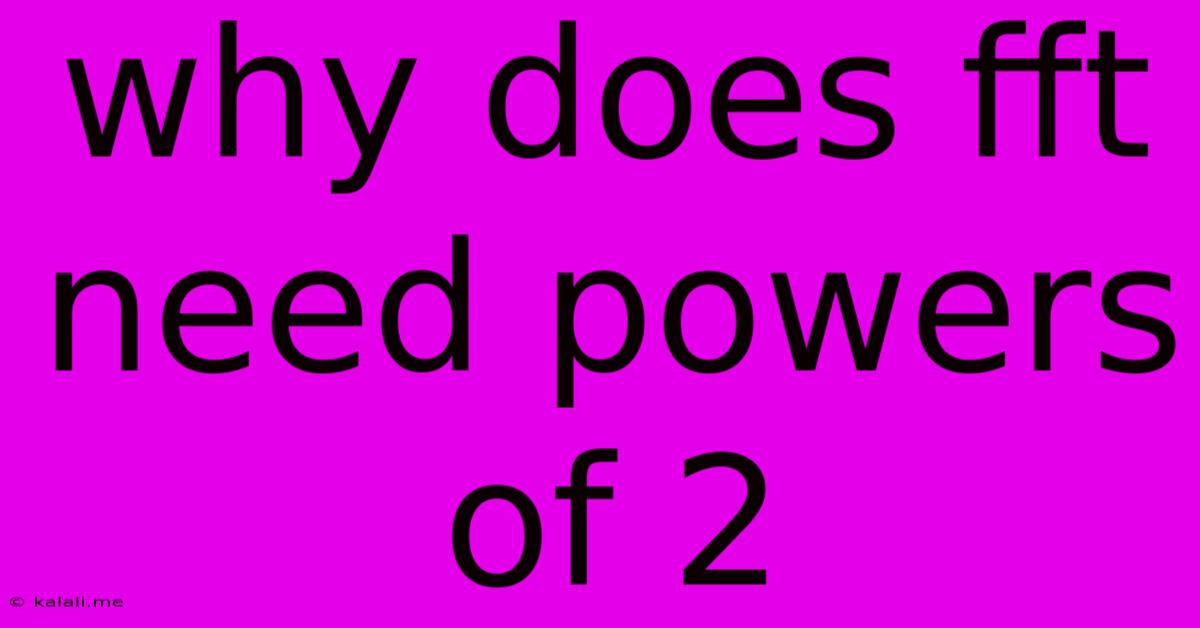Why Does Fft Need Powers Of 2
Kalali
May 23, 2025 · 3 min read

Table of Contents
Why Does the Fast Fourier Transform (FFT) Need Powers of 2? A Deep Dive into Radix-2 Algorithms
The Fast Fourier Transform (FFT) is a remarkably efficient algorithm for computing the Discrete Fourier Transform (DFT). Its speed advantage over a direct DFT calculation is significant, especially for large datasets. However, the most common and highly optimized FFT algorithms rely on input sizes that are powers of two (e.g., 2, 4, 8, 16, 32, etc.). This isn't a strict requirement for all FFT algorithms, but it's crucial for understanding the efficiency of the widely used radix-2 Cooley-Tukey algorithm. This article explores why powers of two are preferred and the implications for data processing.
This article will cover:
- The Core Principle: Divide and Conquer
- Radix-2 FFT: The Power of Two's Efficiency
- Dealing with Non-Power-of-Two Input Sizes
- Modern FFT Libraries and their Handling of Non-Powers of 2
- Conclusion: Balancing Efficiency and Practicality
The Core Principle: Divide and Conquer
The FFT's brilliance lies in its "divide and conquer" approach. Instead of directly calculating each DFT output point, it recursively breaks down the problem into smaller, identical subproblems. This recursive decomposition dramatically reduces the computational complexity. The DFT of a sequence of length N can be calculated in O(N log N) time with an FFT, compared to O(N²) for a direct DFT calculation. This difference becomes enormous as N grows.
Radix-2 FFT: The Power of Two's Efficiency
The most common and highly optimized FFT algorithms are radix-2 algorithms. These algorithms are particularly efficient when the input sequence length, N, is a power of two. This is because they exploit the inherent symmetry and periodicity present within the DFT calculation for powers of two. The decomposition process neatly divides the problem into smaller subproblems of the same size, repeatedly halving the problem until trivial subproblems are reached. This creates a perfectly balanced binary tree structure, maximizing the efficiency of the recursive process. Each level of the tree represents a stage of the algorithm.
Dealing with Non-Power-of-Two Input Sizes
What happens when your data doesn't have a length that's a power of two? Several techniques can be used:
- Zero-Padding: The simplest approach is to pad your data with zeros until the length becomes a power of two. While straightforward, this increases the computation slightly due to processing the extra zeros, potentially impacting accuracy depending on the signal.
- Radix-4, Radix-8, and other Radix Algorithms: These algorithms can handle input sizes that are powers of 4, 8, and other numbers, offering some flexibility. However, radix-2 remains highly optimized in most libraries.
- Mixed-Radix Algorithms: These algorithms combine different radices (e.g., 2, 3, 4, 5) to efficiently handle arbitrary input sizes by breaking down the problem into various subproblems with lengths that fit these radices.
Modern FFT Libraries and their Handling of Non-Powers of 2
Modern FFT libraries, such as FFTW (Fastest Fourier Transform in the West) and others, often employ sophisticated techniques to handle inputs of arbitrary length. These libraries often automatically select the most efficient algorithm based on the input size, utilizing mixed-radix approaches or other optimizations to minimize computational overhead. Therefore, while the radix-2 algorithm thrives on power-of-two inputs, modern libraries largely abstract away this concern for the end-user.
Conclusion: Balancing Efficiency and Practicality
While the classic radix-2 Cooley-Tukey FFT algorithm shines with power-of-two input sizes due to its elegant recursive structure, modern libraries often address non-power-of-two inputs effectively. Zero-padding remains a simple method, though it might slightly increase computation. Understanding these trade-offs is crucial for choosing the right approach depending on data size and application requirements. The emphasis for most users should be on leveraging powerful, optimized FFT libraries rather than manually dealing with power-of-two constraints.
Latest Posts
Latest Posts
-
How To Get Gasoline Smell Off Hands
May 23, 2025
-
How To Reload Chunks In Minecraft
May 23, 2025
-
The Lady Doth Protest Too Much
May 23, 2025
-
Error Bios Legacy Boot Of Uefi Only Media
May 23, 2025
-
How Can You Tell If Chicken Is Done
May 23, 2025
Related Post
Thank you for visiting our website which covers about Why Does Fft Need Powers Of 2 . We hope the information provided has been useful to you. Feel free to contact us if you have any questions or need further assistance. See you next time and don't miss to bookmark.